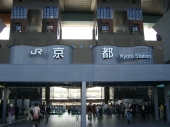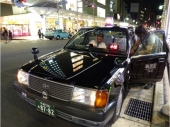Cool- Kyoto is a website in which covers information on Hotels, tour,food,shopping,sightseeing,and more. You are experiencing Japan without even visiting!
 Welcome,Guest User
Welcome,Guest User
Home > Public Transportation in Kyoto
Cool- Kyoto is a website in which covers information on Hotels, tour,food,shopping,sightseeing,and more. You are experiencing Japan without even visiting!
Home > Public Transportation in Kyoto

Few of Kyoto's tourist attractions are located close to subway or train stations. Instead, Kyoto has a dense bus network with direct bus lines from Kyoto Station and/or the city center around Shijo-dori (4th Avenue) and Kawaramachi-dori (Kawaramachi Street) to most major sights.
Kyoto is served by multiple bus companies. For central Kyoto, the green Kyoto City Bus buses are most numerous and useful. The red buses by Kyoto Bus are second most prominent and tend to be convenient to access sights in more outlying areas of the city.
The tourist offices provide a useful English network map for the Kyoto City Buses, which makes it quite easy for foreign visitors to access tourist attractions by bus. Despite the good map and English displays and announcements, however, getting off at the correct bus stop can still be stressful, especially in crowded buses.
Since buses are small and operate surprisingly infrequently even on some major routes, buses to major tourist sights can often get crowded, especially on weekends and during holidays. In addition, much time can be lost when buses get stuck or only proceed slowly in the busy street traffic. Consequently, it is recommended to use subways and trains as much as possible, and use buses only for medium and short distances, for example, from the closest subway station to the destination.
Buses are entered through the back door and left through the front door. The fare has to be paid when leaving the bus. Inside much of central Kyoto, there is a flat rate of 220 yen per ride. Outside the flat fare zone, the fare increases with the distance.
http://www.city.kyoto.jp/koho/eng/access/transport.html

There are two subway lines in Kyoto, the Karasuma Line which runs from south to north along Karasuma-dori (Karasuma Street) and stops at JR Kyoto Station, and the newer Tozai Line which runs from east to west and crosses the Karasuma Line at the intersection of Karasuma-dori and Oike-dori.

All JR lines including the Tokaido Shinkansen pass through or commence at JR Kyoto Station. JR trains are a good option for accessing the Arashiyama area (Sagano Line) and some attractions in southern Kyoto along the JR Nara Line, e.g. Fushimi Inari Shrine and Byodoin in Uji.
• Hankyu Railways connect Kyoto with Osaka. The line initially runs below Shijo Avenue from Kawaramachi westwards in direction of Osaka. It is a good option for accessing the area around Katsura Rikyu, from where a branch line also connects to Arashiyama.
• Keifuku Railways (also known as Randen) operates two tram like train lines in northwestern Kyoto. For train lovers, a ride on these trains is a small attraction by itself. The lines can be an option for accessing Arashiyama and the area around Ryoanji and Kinkakuji.
• Keihan Railways' main line runs next and parallel to Kamo River, but unfortunately does not connect to Kyoto Station. The line continues to Osaka and is an alternative to the JR Nara Line to access some of the attractions in southern Kyoto.
• Eizan Railways operates two train lines from where the Keihan Line ends, Demachi Yanagi Station in northern Kyoto. One line leads to Kurama, while the other runs to the base of Hieizan.
• Kintetsu Railways connects Kyoto Station to Nara. Note that some trains on the Karasuma Subway Line continue to run on the Kintetsu Nara Line, and the other way around.

Kyoto is probably the Japanese city with the highest concentration of taxis. Especially in the city center, taxis are found everywhere. Taxis can not only be a more comfortable, but also an economical alternative to buses on short to medium distances for groups of three or more people.
Most taxis accommodate up to four passengers (not including the driver), while larger vehicles are able to accommodate an additional fifth passenger. The rate starts around 650 yen for the first two kilometers and increases by 80 yen for every additional 300-400 meters traveled.
• Kyoto Sightseeing Card
(1,200 yen for one day, 2,000 yen for two days)
Unlimited usage of Kyoto City Buses, Kyoto Buses and the two subway lines in the city of Kyoto. The 2-day pass can be used on two consecutive days.
• Kyoto City Bus One Day Card (500 yen)
Unlimited use of Kyoto City Buses in central Kyoto. The area of validity is smaller than that of the Kyoto Sightseeing Card, and doesn't include some of the city's more outlying districts, such as Arashiyama.
• Kyoto Subway One Day Card (600 yen)
Unlimited use of Kyoto's two subway lines on one calendar day.
Prepaid cards don't give you any discounts, but they make the process of taking trains and buses easier, as you do not always need to buy a new ticket for each ride. Prepaid cards can be purchased at vending machines.
• Prepaid IC cards (From 2000 yen)
The prepaid IC card available in Kyoto is called Icoca and can be purchased at ticket machines at JR stations. Local non-JR railway companies offer their own IC card called Pitapa; however, Pitapa is a postpaid card that works more like a credit card and is targeted at residents rather than tourists.
Icoca and Pitapa can be used on most means of public transportation in Kyoto and surroundings (and many other major cities in Japan) with the very prominent exceptions of buses in Kyoto and the Eizan Railway that operates to Kurama and Hieizan. Eight other IC cards from other major cities of Japan can be used instead of Icoca cards in Kyoto, including Suica, Pasmo, Kitaca, Toica, Manaca, Sugoca, Nimoca and Hayakaken.
• Surutto Kansai Card (1000, 2000, 3000 and 5000 yen)
The Surutto Kansai Card is an old-fashioned prepaid card that cannot get recharged and is inserted in the ticket gate slot rather than swiped over an IC card reader. Surutto Kansai Cards can be used on virtually all trains and buses in Kyoto and surroundings with the prominent exception of JR trains. The big advantage of Surutto Kansai over Icoca is that it can also be used on Kyoto buses and the Eizan Railway.
The Surutto Kansai Card is also known under various different names, depending through which company you are purchasing it, e.g. Miyako Card (Kyoto subway and city buses) or Lagare Card (Hankyu).

Cycling is an excellent way to get around Kyoto. Bicycles can be rented from the following places
1) Kyoto Cycling Tour Project: Shops near Kyoto Stn. and 2 other key areas and they will also deliver bikes to your hotel/ inn;; Tel: 075-354-3636.
2) Passione: A rental bike shop owned by exbike racer (he speaks English!). Enjoy cycling around Kyoto with top quality bikes;; 9:00-18:00.
Rules and Tips for Cycling in Kyoto
Traffic rules are often different from what you are used to at home: Here are some rules and tips to make your cycling in Kyoto safer and more fun!
1) In Kyoto, as is true of most in most Japanese cities, there are few bicycle paths. Therefore bicycle on sidewalks with pedestrians on big, busy roads. Side streets are always better than main roads for safety and sightseeing.
2) Riding a bicycle after drinking is prohibited (and may be fined 20,000 yen)
3) Do not leave your bicycle on major streets in the downtown core;; Especially around busy subway/train stations. Kyoto City staff frequently remove illegally parked bicycles which have to be retrieved in distant locations plus payment of a fine (2,300 yen/bike). To be safe look for bicycle parking garages (on Kiyamachi, north of Shijo;; in Nijo Station;; in Demachiyanagi Stn.)
4) Bicycle riding is prohibited on some downtown streets. Follow the signs and push your bicycle on these streets.